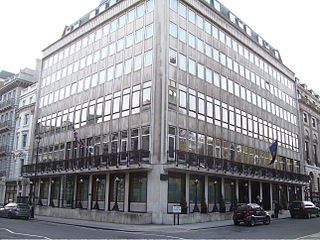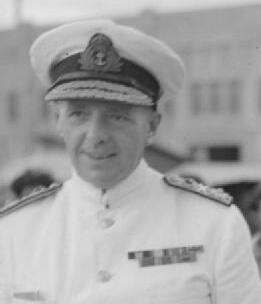
The Second Sea Lord and Deputy Chief of Naval Staff is deputy to the First Sea Lord and the second highest-ranking officer to currently serve in the Royal Navy and is responsible for personnel and naval shore establishments. Originally titled Second Naval Lord in 1830, the post was restyled Second Sea Lord in 1904. They are based at Navy Command, Headquarters.

The post of Controller of the Navy was originally created in 1859 when the Surveyor of the Navy's title changed to Controller of the Navy. In 1869 the controller's office was abolished and its duties were assumed by that of the Third Naval Lord whose title then changed to Third Naval Lord and Controller of the Navy. In 1904 the title was changed again to Third Sea Lord and Controller of the Navy. In 1965 the office of the Third Sea Lord was abolished. The post-holder is responsible for procurement and matériel in the British Royal Navy.

The British Mediterranean Fleet, also known as the Mediterranean Station, was a formation of the Royal Navy. The Fleet was one of the most prestigious commands in the navy for the majority of its history, defending the vital sea link between the United Kingdom and the majority of the British Empire in the Eastern Hemisphere. The first Commander-in-Chief for the Mediterranean Fleet was the appointment of General at Sea Robert Blake in September 1654. The Fleet was in existence until 1967.
Admiral of the Fleet Sir David Benjamin Bathurst, is a former Royal Navy officer. He is the only living person, apart from King Charles III, holding the rank of Admiral of the Fleet in the Royal Navy since the death of Lord Boyce. After training as a pilot and qualifying as a helicopter instructor, Bathurst commanded a Naval Air Squadron and then two frigates before achieving higher command in the navy. He served as First Sea Lord and Chief of the Naval Staff from 1993 to 1995: in that capacity he advised the British Government on the deployment of Naval Support including Sea Harriers during the Bosnian War.

The Commander-in-Chief, The Nore, was an operational commander of the Royal Navy. His subordinate units, establishments, and staff were sometimes informally known as the Nore Station or Nore Command. The Nore is a sandbank at the mouth of the Thames Estuary and River Medway. In due course the Commander-in-Chief became responsible for sub-commands at Chatham, London, Sheerness, Harwich and the Humber.

The Channel Fleet and originally known as the Channel Squadron was the Royal Navy formation of warships that defended the waters of the English Channel from 1854 to 1909 and 1914 to 1915.

The Royal Naval College, Osborne, was a training college for Royal Navy officer cadets on the Osborne House estate, Isle of Wight, established in 1903 and closed in 1921.
Stubbington House School was founded in 1841 as a boys' preparatory school, originally located in the Hampshire village of Stubbington, around 1 mile (1.6 km) from the Solent. Stubbington House School was known by the sobriquet "the cradle of the Navy". The school was relocated to Ascot in 1962, merging with Earleywood School, and it closed in 1997.

The Army and Navy Club in London is a private members club founded in 1837, also known informally as The Rag.

Admiral Sir Arthur Francis Eric Palliser, was a prominent Royal Navy officer during the Second World War.

The Naval Secretary is the Royal Navy officer who advises the First Sea Lord and Chief of Naval Staff on naval officer appointing.

The Commander-in-Chief, Portsmouth, was a senior commander of the Royal Navy for hundreds of years. The commanders-in-chief were based at premises in High Street, Portsmouth from the 1790s until the end of Sir Thomas Williams's tenure, his successor, Sir Philip Durham, being the first to move into Admiralty House at the Royal Navy Dockyard, where subsequent holders of the office were based until 1969. Prior to World War I the officer holder was sometimes referred to in official dispatches as the Commander-in-Chief, Spithead.
Admiral Sir Robert Hastings Penruddock Harris KCB, KCMG was a Royal Navy officer who went on to be Commander-in-Chief, Cape of Good Hope Station.

Vice-Admiral Arthur Edward Frederick Bedford, CB, CSI was a Royal Navy officer. He served in HMS Kent at the Battle of the Falkland Islands of 1914 and rose to command the Royal Indian Navy from 1934 to 1937, when he retired. A year later he rejoined the colours and served until the end of the Second World War.
Rear Admiral Martin Noel Lucey CB DSC was a Royal Navy officer who became Flag Officer, Scotland and Northern Ireland and Admiral President Royal Naval College, Greenwich.
Vice Admiral Sir Geoffrey William Roger Biggs, was a senior Royal Navy officer who served as Deputy Commander-in-Chief Fleet from 1992 to 1995.
Eastman's Royal Naval Academy, originally in Southsea and later at Winchester, both in England, was a preparatory school. Between 1855 and 1923 it was known primarily as a school that prepared boys for entry to the Royal Navy. Thereafter, it was renamed Eastman's Preparatory School and continued until the 1940s. According to Jonathan Betts, it was "considered one of the top schools for boys intended for the Navy".

The Commander-in-Chief, North Sea, was senior appointment and an operational command of the British Royal Navy originally based at Great Yarmouth from 1745 to 1802 then at Ramsgate from 1803 until 1815.










